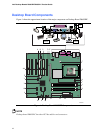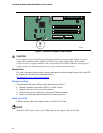
Desktop Board Features
19
Enhanced IDE Interface
The ICH5’s IDE interface handles the exchange of information between the processor and
peripheral devices like hard disks, CD-ROM drives, and Iomega Zip* drives inside the computer.
The interface supports:
• Up to four IDE devices (such as hard drives)
• ATAPI-style devices (such as CD-ROM drives)
• Older PIO Mode devices
• Ultra DMA-33 and ATA-66/100 protocols
• Laser Servo (LS-120) drives
Accelerated Graphics Port (AGP)
NOTE
Desktop Board D865GBF/D865GLC is only compatible with 0.8 V and 1.5 V AGP cards.
The AGP connector is keyed for 0.8 V and 1.5 V AGP cards only; the connector is not mechanically
compatible with legacy 3.3 V AGP cards. Do not attempt to install a legacy 3.3 V AGP card.
AGP is a high-performance interface for graphics-intensive applications, such as 3D graphics.
AGP is independent of the PCI bus and is intended for exclusive use with graphical display devices.
The AGP 3.0 connector supports 8x, 4x, and 1x AGP cards.
Related Links:
For information about installing the AGP card, see page 35 in Chapter 2.
BIOS
The BIOS provides the Power-On Self-Test (POST), the BIOS Setup program, the PCI and IDE
auto-configuration utilities, and the video BIOS. The BIOS is stored in the Firmware Hub.
The BIOS can be updated by following the instructions in Chapter 3 on page 49.
PCI Auto Configuration
If you install a PCI add-in card in your computer, the PCI auto-configuration utility in the BIOS
automatically detects and configures the resources (IRQs, DMA channels, and I/O space) for that
add-in card. You do not need to run the BIOS Setup program after you install a PCI add-in card.
IDE Auto Configuration
If you install an IDE device (such as a hard drive) in your computer, the IDE auto-configuration
utility in the BIOS automatically detects and configures the device for your computer. You do not
need to run the BIOS Setup program after installing an IDE device. You can override the auto-
configuration options by specifying manual configuration in the BIOS Setup program.
To use ATA-66/100 features, the following items are required:
• An ATA-66/100 peripheral device
• An ATA-66/100 compatible cable
• ATA-66/100 operating system device drivers


















